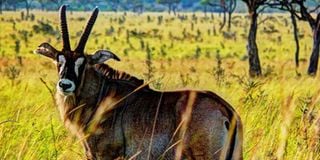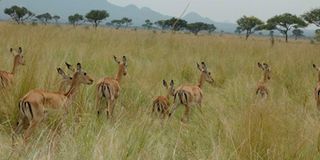Premium
Kenya steps up efforts to save wildlife from extinction

A Roan antelope in Ruma National Park in Homa Bay County. The antelope is facing extinction.
What you need to know:
- At least 1,739 rhinos, including the only existing two northern white rhinos, were counted in the census whose results were released Tuesday.
- The report notes that sable antelopes and mountain bongos, whose numbers were already less than 100 each, require special attention as they are facing extinction.
The black rhino, mountain bongo, roan antelope and sable antelope have been classified as critically endangered species in Kenya.
The inaugural wildlife census by the Ministry of Tourism has revealed continued pressure of human activities on wildlife and their habitats in most ecosystems, and that is unlikely that majority of the wildlife species will co-exist with livestock or in areas with high density of human settlements.
At least 1,739 rhinos, including the only existing two northern white rhinos, were counted in the census whose results were released Tuesday. Of these, 897 are the critically endangered black rhinos and 840 are the southern white rhinos.
The report notes that sable antelopes and mountain bongos, whose numbers were already less than 100 each, require special attention as they are facing extinction.
Of concern also is the Grevy’s zebra -- the world’s rarest -- which is in danger of becoming extinct.
According to the wildlife census conducted in various parts of the country between January and May, the population of the Grevy’s zebra that once roamed various parts of Africa is down to 2,649 down from 2,812 in 2018.About 38 per cent of these were found in Laikipia County.

Impalas at Ruma National Park in Homa Bay County.
The population has fallen dramatically from historical levels of 25,000 in the 1970s to about 3,000 today in the world.
Although the statistics in the report show the elephant population has increased from 32,214 animals in 2014 to the current 36,169 animals, poaching remains a threat to the jumbos and rhinos.
“The population reduced from 35,588 elephants in 2012 to 32,214 elephants in 2014,” the report shows, but also indicates that since then, the elephant population has increased due to heightened conservation efforts, both by the government agencies and private conservators.
The International Union for Conservation of Nature (IUCN) had in March warned that poaching and habitat destruction due to agriculture was devastating elephant numbers across Africa.
The giraffe population also recorded growth from about 23,000 animals in 2019 to about 34,240 animals in 2021. The ministry has attributed this to penalties on crimes related to threatened species.
Also increasing is the population of lions, zebras and hirolas (Hunter’s antelope).
The Maasai Mara, Tsavo, Lake Nakuru National Park, Marsabit and Laikipia-Samburu-Marsabit ecosystems account for about 78 per cent of the total buffalo population in Kenya, according to the report.
President Uhuru Kenyatta, while receiving the report from Tourism Cabinet Secretary Najib Balala, applauded efforts by the government and private conservation agencies in successfully clamping down on poaching.
“The reduction in losses in terms of elephants, rhinos and other endangered species is because of the great work that the Kenya Wildlife Service, its officers and men are doing,” he said.
Mr Balala said the data from the census would inform policy, planning and assessment of areas that require focus.
KWS Director General John Waweru said there is need to conduct the census every three years in line with wildlife ecological cycles.





